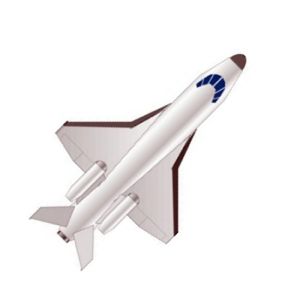
Home - Search - Browse - Alphabetic Index: 0- 1- 2- 3- 4- 5- 6- 7- 8- 9
A- B- C- D- E- F- G- H- I- J- K- L- M- N- O- P- Q- R- S- T- U- V- W- X- Y- Z
Rocketplane XP
 Rocketplane XP Credit: Rocketplane Kistler |
Status: Study 2015. Thrust: 160.00 kN (35,960 lbf). Gross mass: 8,840 kg (19,480 lb). Unfuelled mass: 4,340 kg (9,560 lb). Height: 13.00 m (42.00 ft). Diameter: 1.50 m (4.90 ft). Span: 7.50 m (24.60 ft).
The vehicle would take off from a conventional airfield using turbojets, then use a rocket engine to accelerate to 1100 m/s, which would allow it to zoom to 100 kilometers and provide three to four minutes of zero-G.
The fighter-sized vehicle was fitted with a delta wing and a V-tail which provided good flight characteristics both subsonically and supersonically. The cabin environment was designed to maintain a comfortable temperature and pressure for the occupants while providing an excellent view of the Earth from space. It was constructed with many of the same systems as a conventional jet aircraft, but included features required for flight in space including a rocket engine, reaction control system (RCS), and internal air supply to provide a 0.7 atmosphere cabin pressure.
The thermal protection system, wing propellant tanks, and other systems were designed with the possibility of eventual upgrade to a longer-range aircraft.
In a typical mission, rocket ignition would take place between 6000 and 9000 m altitude with the spaceplane in horizontal jet flight. A 3 to 4-G ascent profile would be flown, with engine cut-off at Mach 3.5 at 45,000 m after 70 seconds of rocket powered flight. After up to four minutes of weightlessness, the passengers would pull 3 to 4 G's on re-entry, followed by a glide to a landing at the departure airfield after a one-hour flight. After a three to five day turnaround, the rocketplane would be ready for another flight.
Rocketplane XP subsystems included:
- Environmental Control and Life Support System using cryogenic liquid nitrogen and liquid oxygen and a chemical scrubbing agent to remove carbon dioxide.
- Two CJ610 business jet engines, derived from the military J-85, for takeoff and ascent to rocket ignition altitude.
- A Polaris Propulsion AR-36 160 kN liquid oxygen / kerosene regeneratively-cooled rocket engine with the injector based on the Atlas sustainer engine design. All composite tanks in the aft fuselage would be helium pressurized. A Barber Nichols turbopump, driven by hydrogen peroxide monopropellant, would deliver the propellants to the combustion chamber.
- A Space Vector reaction control system consisting of 12 cold nitrogen gas thrusters placed in opposing pairs.
- A Utah State University Flush Air Data System to determine pressure, airspeed, air density, alpha, and stall warning at all speeds, attitudes, and altitudes.
- An all electric, fly-by-wire flight control system with an elevon and aileron on each wing, and all-moving tail. Pilot inputs were processed by triple redundant flight control computers. Electromechanical actuators operating on 270VDC power drive the control services.
- An Electrical Power System mainly driven by a set of large lithium-ion batteries.
- An advanced fault tolerant BD Systems GN&C control and navigation system which takes inputs from the Flush Air Data System, a Global Positioning System (GPS), and an Inertial Navigation System.
- An ARINC, Data Acquisition and Integrated Vehicle Health Management System
- A thermal protection system to handle the 300 deg C re-entry heating, consisting of titanium leading edges and control services, and a special ceramic paint with a 93% emissivity on the rest of the aircraft.
Crew Size: 6. Crew: 430 kg (940 lb).
Family: New Space Tourism, Spaceplane, Suborbital, US Rocketplanes. Country: USA. Engines: RS-88. Propellants: Lox/Kerosene. Agency: Spaceplane USA.
Back to top of page
Home - Search - Browse - Alphabetic Index: 0- 1- 2- 3- 4- 5- 6- 7- 8- 9
A- B- C- D- E- F- G- H- I- J- K- L- M- N- O- P- Q- R- S- T- U- V- W- X- Y- Z
© 1997-2019 Mark Wade - Contact
© / Conditions for Use